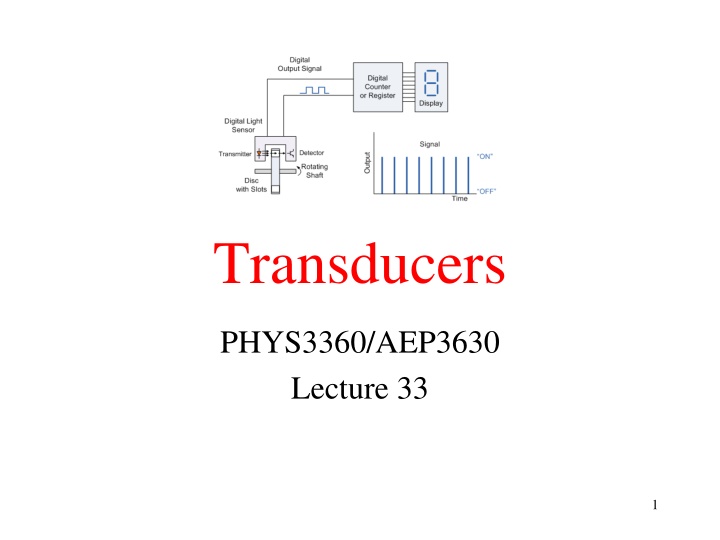
Transducers and Sensor Terminology in Technology
Explore the world of transducers in technology, where energy is converted from one form to another. Learn about sensor types, including passive and active sensors, as well as positional sensors like potentiometers and inductive proximity switches. Discover a range of transducer types and their applications in various devices.
Download Presentation

Please find below an Image/Link to download the presentation.
The content on the website is provided AS IS for your information and personal use only. It may not be sold, licensed, or shared on other websites without obtaining consent from the author. If you encounter any issues during the download, it is possible that the publisher has removed the file from their server.
You are allowed to download the files provided on this website for personal or commercial use, subject to the condition that they are used lawfully. All files are the property of their respective owners.
The content on the website is provided AS IS for your information and personal use only. It may not be sold, licensed, or shared on other websites without obtaining consent from the author.
E N D
Presentation Transcript
Transducers PHYS3360/AEP3630 Lecture 33 1
Terminology Transducers convert one form of energy into another Sensors/Actuators are input/output transducers Sensors can be passive (e.g. change in resistance) or active (output is a voltage or current level) Sensors can be analog (e.g. thermocouples) or digital (e.g. digital tachometer) Sensor Actuator 2
Transducer types Quantity being Measured Input Device (Sensor) Output Device (Actuator) Light Dependant Resistor (LDR), Photodiode, Phototransistor, Solar Cell Thermocouple, Thermistor, Thermostat, Resistive temperature detectors (RTD) Strain Gauge, Pressure Switch, Load Cells Potentiometer, Encoders, Reflective/Slotted Opto-switch, LVDT Tacho-generator, Reflective/Slotted Opto-coupler, Doppler Effect Sensors Carbon Microphone, Piezo-electric Crystal Lights & Lamps, LED's & Displays, Fiber Optics Heater, Fan, Peltier Elements Lifts & Jacks, Electromagnetic, Vibration Motor, Solenoid, Panel Meters AC and DC Motors, Stepper Motor, Brake Light Level Temperature Force/Pressure Position Speed Sound Bell, Buzzer, Loudspeaker 3
Positional Sensors: potentiometer Can be Linear or Rotational Processing circuit 4
Positional Sensors: LVDT Linear Variable Differential Transformer 5
Positional Sensors: Inductive Proximity Switch Detects the presence of metallic objects (non-contact) via changing inductance Sensor has 4 main parts: field producing Oscillator via a Coil; Detection Circuit which detects change in the field; and Output Circuit generating a signal (NO or NC) Used in traffic lights (inductive loop buried under the road). Sense objects in dirty environment. Does not work for non-metallic objects. Omni-directional. 6
Positional Sensors: Rotary Encoders Incremental and absolute types Incremental encoder needs a counter, loses absolute position between power glitches, must be re-homed Absolute encoders common in CD/DVD drives 7
Temperature Sensors Bimetallic switch (electro-mechanical) used in thermostats. Can be creep or snap action. Creep-action: coil or spiral that unwinds or coils with changing temperature Thermistors (thermally sensitive resistors); Platinum Resistance Thermometer (PRT), very high accuracy. 8
Thermocouples Two dissimilar metals induce voltage difference (few mV per 10K) electro-thermal or Seebeck effect Use op-amp to process/amplify the voltage Absolute accuracy of 1K is difficult 9
Light sensors: photoconductive cells Light dependent resistor (LDR) cell 11
Photojunction devices phototransistor photodiode 13
Photovoltaic Solar Cells Can convert about 20% of light power into electricity Voltage is low (diode drop, ~0.6V) Solar power is 1.4kW/m^2 14
Photomultiplier tubes (PMT) Most sensitive of light sensors (can detect individual photons) Acts as a current source electrons 15
Motion sensors/transducers Switches, solenoids, relays, motors, etc. Motors DC Brushed/brushless Servo Stepper motors AC Stepper motor 16 Brushed motor permanent magnets on armature, rotor acts as electromagnet Brushless motor permanent magnet on the rotor, electromagnets on armature are switched
Sound transducers speaker microphone Note: voice coil can also be used to generate fast motion 17
Piezo transducers Detect motion (high and low frequency) Sound (lab this week), pressure, fast motion Cheap, reliable but has a very limited range of motion 18
Summary We ve only briefly touched on most basic types Many other transducers are used/common, almost for any physical quantity one can think of Processing electronics is often essential: output of many sensors is not linear, needs impedance transform, filtering, etc. For additional references see http://www.electronics-tutorials.ws/io/io_1.html Handbook of Transducers by H.N. Norton http://www.sparkfun.com 19
